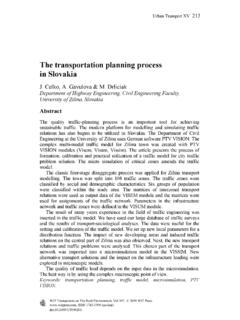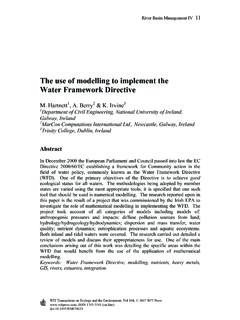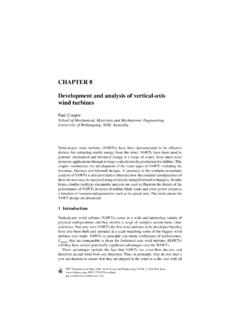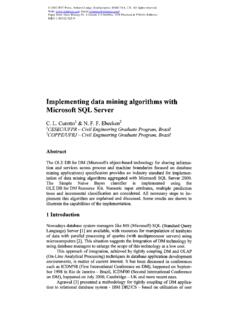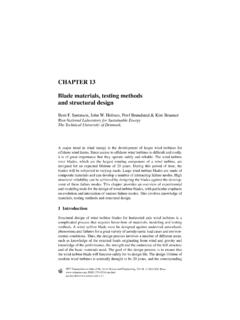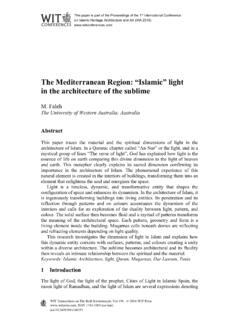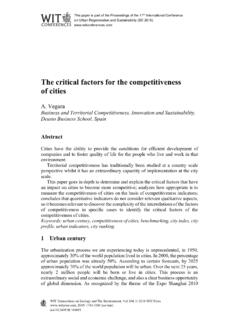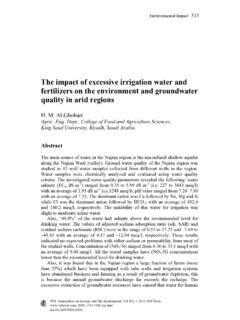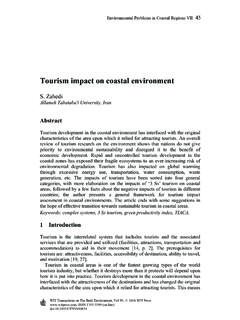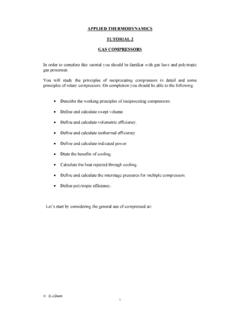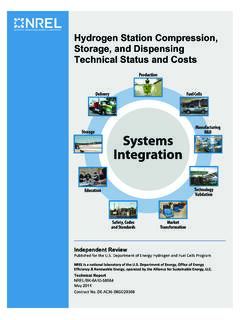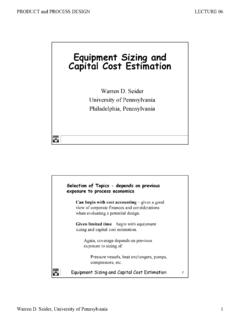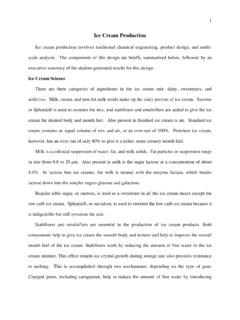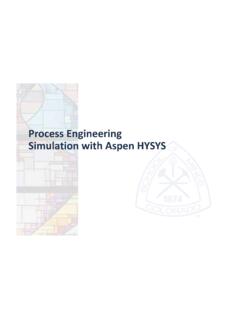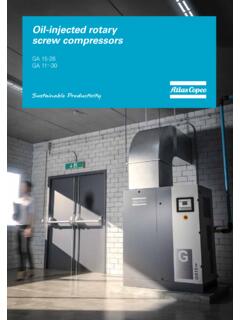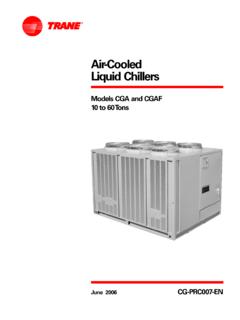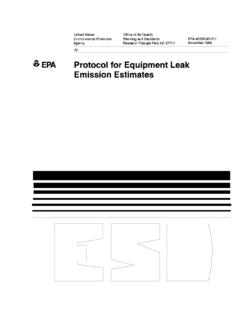Transcription of CHAPTER 9 Design and optimization of Turbo compressors
1 CHAPTER 9 Design and optimization of Turbo compressorsC. Xu & AmanoDepartment of Mechanical Engineering, University of Wisconsin-Milwaukee, compressor has been refereed to raise static enthalpy and pressure. A successful compressor Design greatly benefi ts the performance of the whole power system. Lean Design methodologies have been used for industrial power system Design . The compressor designs require benefi t to both OEM and customers, lowest cost for both OEM and end users and high effi ciency in all operating range of the compressor . The compressor Design and optimization are critical for the new com-pressor development and compressor upgrade. The Design experience and Design considerations are also critical for a successful compressor Design . The Design experience can accelerate compressor lean Design process . An optimization pro-cess is discussed to Design compressor blades in Turbo machinery. The compressor Design process is not only an aerodynamic optimization , but structure analyses also need to be combined in the optimization .
2 This CHAPTER discusses an aerodynamic and structure integration optimization process . The Design method consists of an airfoil shape optimization and a three-dimensional gradient-based optimization coupled with Navier Stokes solvers. A model airfoil of a transonic compressor is designed by using this approach, with an effi ciency improvement. Airfoil sections were stacked up to a three-dimensional rotor blade of a compressor . The effi ciency is improved over a wide range of mass fl ow. The results indicate that the optimiza-tion process can provide improved Design and can be integrated into a compressor Design procedure. Initial Design considerations of Turbo compressor are commonly performed with experience base, although computer technology and numerical methods have made a signifi cant progress. Three-dimensional computational fl uid dynamics codes are still not major Design tools for compressors . Major Design systems for industrial compressor Design are largely based on one-dimensional mean line and two-dimensional through fl ow tools.
3 The experience of designers is one of the key factors to drive Design success. The discussions and information , ISSN 1755-8336 (on-line) WIT Transactions on State of the Art in Science and Engineering, Vol , 20 WIT Press4208 Thermal Engineering in Power Systemson compressor Design considerations in open literature are also reviewed. This CHAPTER consists of three parts: Part I provides an overview of the Turbo compres-sors and basic Design procedures. Part II discusses a blade optimization process . An axial compressor blade Design was used as an example to illustrate the optimal Design . Part III provides some Design experience of centrifugal Part I: compressors and their IntroductionCompressors are devices to pressurize working gases. One of the basic applica-tions for the compressors is to increase the gas pressure and deliver gas to the downstream of the compressor . For example, compressors can provide higher-pressure gas for combustion, high-pressure gas to drive gas tools, transport process gas through pipelines, or compressor gas for heat recovery or gas conditioning can be separated into two basic types: The positive displacement and continuous fl ow compressors .
4 The reciprocating and rotary compressors are two major positive displacement compressors . Ejectors and Turbo compressors are the two main continuous compressors . Axial and centrifugal compressors are the two basic types of Turbo compressors . The main purpose of this part is to describe an industrial Turbo compressor Design turbine and compressor manufactures are competing to produce more effi -cient and wide operating range machines. Correspondingly, many research works and developments were carried out to meet the manufacturers needs [1 8]. Com-pressor blade Design is one of the critical processes to ensure the overall compres-sor have good performance. For all the Turbo compressors , there are two major parts: rotating blade and stationary blade. The basic functions of compressor mov-ing blades are added the work to gas and turn the gas to the required angles to have diffusion in the fl ow path to increase the static pressure and discharge to next com-ponent.
5 For the stationary blades, the basic function is to turn the gas to the required angles to have a right diffusion level for the gas. The Design goal for modern com-pressor blades are to achieve the desired fl ow turning with minimum losses and can tolerance high incident within the constraint of geometric orientation of the blade row requirements defi ned by overall compressor rotating and stationary blades involve the airfoil and blade designs. The basic compressor blade performance was mainly determined by fi ve key factors: shape of the blades, airfoil or blade section stagger angle, solidity, inlet and dis-charge fl ow angle, airfoil or blade section loading. Unlike turbine blades through which fl ows are accelerated, the adverse pressure gradient due to the fl ow diffu-sion in compressor blades. The adverse pressure is an unfavorable force on the boundary layer development. It is very diffi cult to achieve a thin boundary layer.
6 The boundary layer separation often happens inside the compressors . Therefore, the main challenge for compressor blade Design is to generate a blade shape to meet the fl ow angle requirements and reasonable loading distributions. , ISSN 1755-8336 (on-line) WIT Transactions on State of the Art in Science and Engineering, Vol , 20 WIT Press4208 Design and optimization of Turbo compressors 307 Effi ciency had been a major criterion in the Design of compressor and turbine components for many years. The search for maximum effi ciency is traditionally made by successive modifi cations of the geometries and verifi cation by wind tun-nel tests and fl ow calculations. Such a process can be time consuming and out-come strongly depended on the designs experiences. This approach is diffi cult to have advanced Design such as shock-free transonic blades and blades with optimized Design methods were proposed in both research stage and industrial appli-cations [1 9].
7 The blade Design methods can be categorized into two basic meth-ods. One is direct Design and another is inverse Design method. For direct Design method, blade was Design fi rst based on the designer experience and then a Navier Stokes equation code or a fast inviscid code was used to evaluate the airfoil perfor-mance. The process of Design and performance calculations are completed until a satisfy airfoil was built. The designed airfoils are then stack-upped to produce a three-dimensional blade. Normally, some three dimensional optimization pro-cesses are used to continue optimizing the Design [1 9]. In inverse Design method [5], normally Euler equations with modifi ed boundary conditions were used for an iterative procedure to search the desired the rapid progress in computational fl uid dynamics (CFD) and computer technologies, compressor Design has been developed from purely empirical meth-ods to apply more CFD simulation into Design process .
8 The CFD method allows the aerodynamic designer to have detailed fl ow information and to optimize the blades. However, at the beginning stage of the Design , the experience data are very helpful to accelerate the Design and provide the basic information, to engineers in other discipline. In this CHAPTER , we will start with basic introduction of the com-pressor, and then talk about Design process and optimization , and fi nally the Design experience the author will be Types of Turbo compressorsTurbo compressors can be categorized into two types: compressors and turbines. compressors absorb power to increase the fl uid pressure or head, and turbines produce power by expanding fl uid to a lower pressure or head. compressors have a wide application in order to provide the high-pressure gas for combustion in jet engines, to transfer process fl uid in pipelines, to provide high-pressure gas to driving tools, etc. The compressor system is one of the important parts of a power system.
9 Both centrifugal compressors and axial compressors are continuous fl ow are categorized into three types according to the nature of the fl ow path through the passages of the rotors. When the fl uid through fl ow path is wholly or mainly parallel to the axis of rotation, these types of compressors called axial compressors as shown in Fig. 1a. Centrifugal compressors having through fl ow paths are wholly or mainly in a plane perpendicular to the rotational axial as shown in Fig. 1b. When the through fl ow in the compressors has a signifi cant amount of velocities in both radial and axial directions, we call this type of compressors as , ISSN 1755-8336 (on-line) WIT Transactions on State of the Art in Science and Engineering, Vol , 20 WIT Press4208308 Thermal Engineering in Power Systemsmixed fl ow compressors as shown in Fig. Sometimes, mixed fl ow compressors are also reference as centrifugal axial compressor was fi rst patented by Sir Charles Parsons in 1884 [10].
10 His compressor concept just simply reversing an axial turbine for use as a com-pressor; however, the effi ciency of compressors from reversing turbines was less than 40%. The diffi culties associated with the development of axial compressors stemmed from the fundamentally different nature of the fl ow process compared with that in axial-fl ow turbine. It was not until 1926 that any further improvement on axial compressor effi ciency was undertake when Griffi th [11] outlined the basic principles of airfoil theory of compressor and turbine fl ow compressors are the most common types of compressor for aircraft engines and big industrial gas turbine. The gas in an axial compressor fl ows in an axial direction through a series of rotating rotor blades and stationary stator vanes. The fl ow path of an axial compressor decreases in cross-section area in the direc-tion of fl ow, reducing the volume of the gas as compression progresses from stage to stage of compressor axial compressors as shown in Fig.
